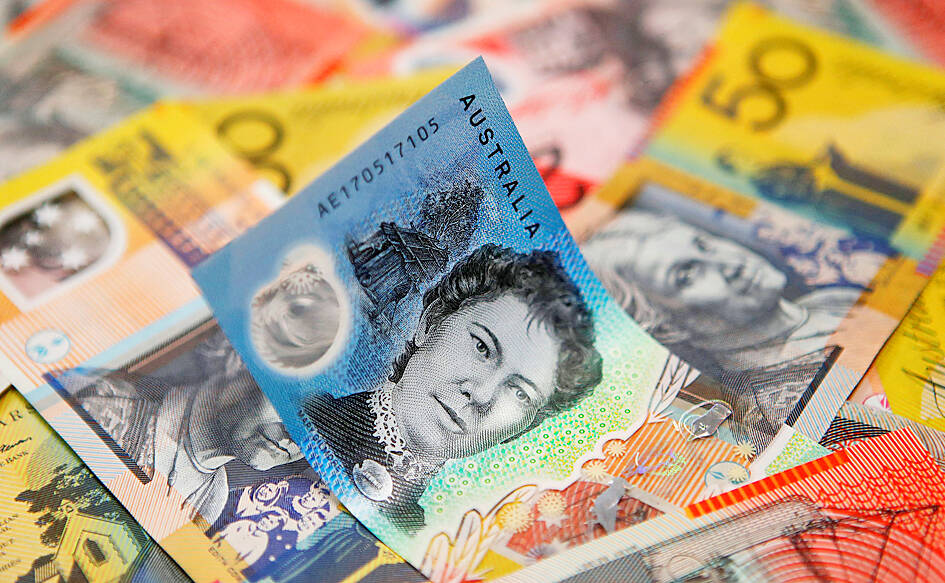Australia is to erase the British monarch from its banknotes, replacing Queen Elizabeth II’s image on its A$5 note with a design honoring indigenous culture, the Australian central bank said yesterday.
The decision to leave her successor, King Charles III, off the A$5 note means no monarch would remain on Australia’s paper currency.
The Reserve Bank of Australia said it would consult indigenous people on a new design that “honors the culture and history of the first Australians.”

Photo: REUTERS
The queen’s death on Sept. 8 last year was marked by public mourning in Australia, but some indigenous groups also protested against the destructive impact of colonial Britain, calling for the abolition of the monarchy.
Australia is a constitutional monarchy, a democracy with Charles III as its head of state. A referendum proposing a switch to a republic was narrowly defeated in 1999.
The central bank said that its decision was supported by the center-left Labour government of Australian Prime Minister Anthony Albanese, who favors an eventual move to an Australian republic.
The new banknote would take “a number of years” to be designed and printed, it said, adding that the existing A$5 note would remain legal tender even after the new design is in people’s hands.
The bank’s move was hailed by the head of Australia’s republican movement, who said that indigenous people predated British settlement by 65,000 years.
“Australia believes in meritocracy so the idea that someone should be on our currency by birthright is irreconcilable, as is the notion that they should be our head of state by birthright,” Australian Republic Movement chairman Craig Foster said.
“To think that an unelected king should be on our currency in place of First Nations leaders and elders and eminent Australians is no longer justifiable at a time of truth-telling, reconciliation and ultimately formal, cultural and intellectual independence,” he said.
The Australian Monarchist League said the decision was “virtually neo-communism in action.”
“Before a referendum is held on whether the people want to retain the King as sovereign or opt for a President, this government has arbitrarily moved to discard the King’s head from Australia’s five dollar note,” the group said in a statement. “It is certainly not Australian democracy.”
A British monarch has featured on Australian banknotes since 1923 and was on all paper bills until 1953, the year of Elizabeth II’s coronation.
The queen’s face adorned the 1 Australian pound banknote and, after the adoption of the Australian dollar in 1966, the A$1 note.
That first A$1 banknote also included imagery of Aboriginal rock paintings and carvings based on a bark painting by indigenous artist David Malangi Daymirringu.
The queen’s face has peered up at Australians from the polymer A$5 note since 1992.
However, central bank Governor Philip Lowe last year announced that the bank had begun talking with the Albanese administration about whether to forgo replacing the queen’s image with a portrait of King Charles III.
The bank has made no mention of any plans to remove the monarch’s image from Australian coins.

Former Nicaraguan president Violeta Chamorro, who brought peace to Nicaragua after years of war and was the first woman elected president in the Americas, died on Saturday at the age of 95, her family said. Chamorro, who ruled the poor Central American country from 1990 to 1997, “died in peace, surrounded by the affection and love of her children,” said a statement issued by her four children. As president, Chamorro ended a civil war that had raged for much of the 1980s as US-backed rebels known as the “Contras” fought the leftist Sandinista government. That conflict made Nicaragua one of

COMPETITION: The US and Russia make up about 90 percent of the world stockpile and are adding new versions, while China’s nuclear force is steadily rising, SIPRI said Most of the world’s nuclear-armed states continued to modernize their arsenals last year, setting the stage for a new nuclear arms race, the Stockholm International Peace Research Institute (SIPRI) said yesterday. Nuclear powers including the US and Russia — which account for about 90 percent of the world’s stockpile — had spent time last year “upgrading existing weapons and adding newer versions,” researchers said. Since the end of the Cold War, old warheads have generally been dismantled quicker than new ones have been deployed, resulting in a decrease in the overall number of warheads. However, SIPRI said that the trend was likely

NUCLEAR WARNING: Elites are carelessly fomenting fear and tensions between nuclear powers, perhaps because they have access to shelters, Tulsi Gabbard said After a trip to Hiroshima, US Director of National Intelligence Tulsi Gabbard on Tuesday warned that “warmongers” were pushing the world to the brink of nuclear war. Gabbard did not specify her concerns. Gabbard posted on social media a video of grisly footage from the world’s first nuclear attack and of her staring reflectively at the Hiroshima Peace Memorial. On Aug. 6, 1945, the US obliterated Hiroshima, killing 140,000 people in the explosion and by the end of the year from the uranium bomb’s effects. Three days later, a US plane dropped a plutonium bomb on Nagasaki, leaving abut 74,000 people dead by the

Indian Prime Minister Narendra Modi is to visit Canada next week, his first since relations plummeted after the assassination of a Canadian Sikh separatist in Vancouver, triggering diplomatic expulsions and hitting trade. Analysts hope it is a step toward repairing ties that soured in 2023, after then-Canadian prime minister Justin Trudeau pointed the finger at New Delhi’s involvement in murdering Hardeep Singh Nijjar, claims India furiously denied. An invitation extended by new Canadian Prime Minister Mark Carney to Modi to attend the G7 leaders summit in Canada offers a chance to “reset” relations, former Indian diplomat Harsh Vardhan Shringla said. “This is a